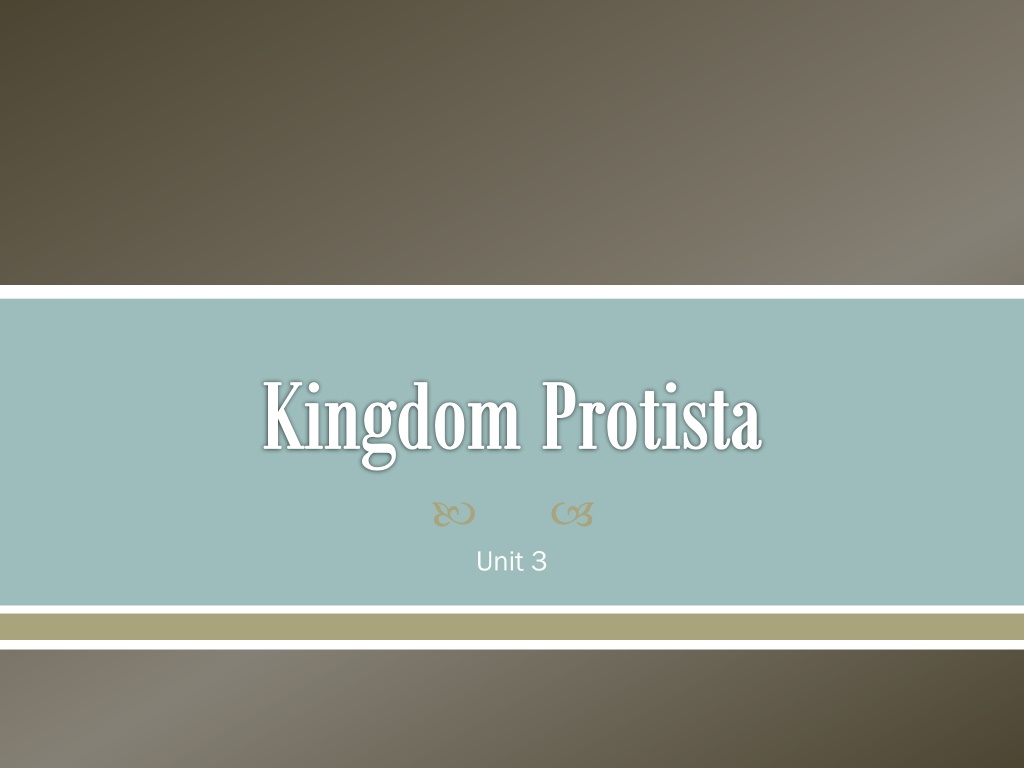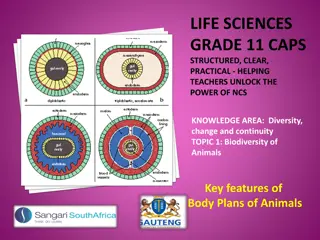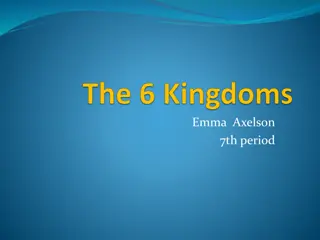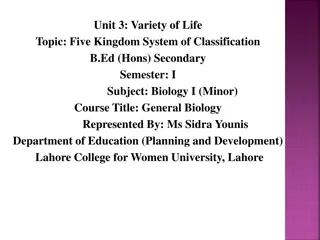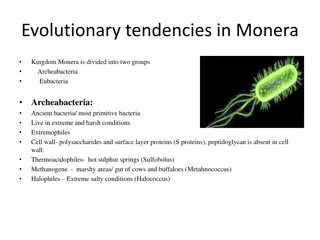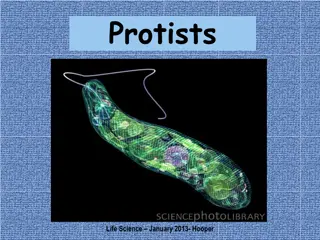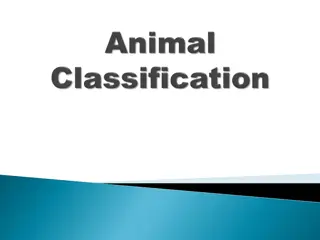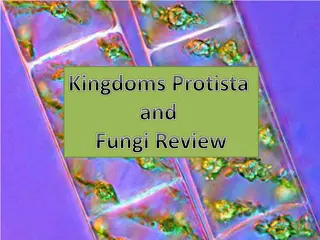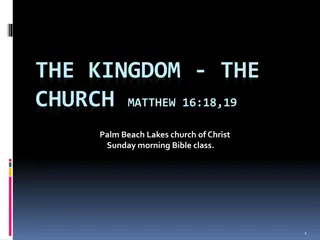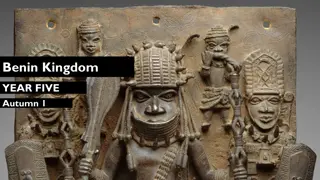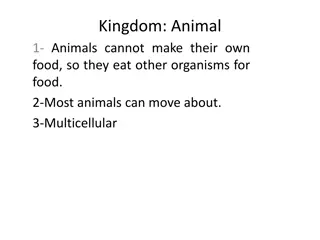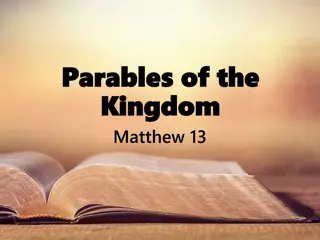Exploring the Fascinating Kingdom Protista: Classification and Characteristics
Dive into the diverse world of Kingdom Protista, encompassing a wide range of eukaryotic organisms not classified under animals, plants, or fungi. Discover their classification based on nutrition acquisition and explore animal-like protists, such as zooflagellates, sarcodines, ciliates, and sporozoans, each with unique features and movements. Unveil the intriguing characteristics of protists, including amoeba's flexible pseudopods and paramecium's cilia-driven feeding, and learn about the parasitic nature of sporozoans.
Download Presentation

Please find below an Image/Link to download the presentation.
The content on the website is provided AS IS for your information and personal use only. It may not be sold, licensed, or shared on other websites without obtaining consent from the author. Download presentation by click this link. If you encounter any issues during the download, it is possible that the publisher has removed the file from their server.
E N D
Presentation Transcript
Kingdom Protista Unit 3
What is a Protist? Protists are eukaryotes that are not member of the Plant, Animal or Fungi kingdoms. Most (but not all) are unicellular
Classification of Protists One way protists can be classified is by how they obtain nutrition: o Heterotrophs- called animal-like protists o Photosynthesizers- called plant-like protists o Decomposers and parasites- called fungus-like protists. https://encrypted-tbn2.gstatic.com/images?q=tbn:ANd9GcQDV45DZyW36k1SQtBC7cgxLq0GyN9-ctngxKTF7EE3NQ-5c5wq https://encrypted-tbn0.gstatic.com/images?q=tbn:ANd9GcRpgD5ZNAFYPWWHVHmvpT9c1NHnrp06pJD7L9Eo_ZieuE_eVpkbtg Fungus-like: Slime Molds Slime Molds Plant-like: Euglena Euglena Animal-like: Amoeba Amoeba
Animal-Like Protists There are four phyla of animal-like protists o Zooglagellates o Sarcodines o Ciliates o Sporozoans Animal-like protists are classified by their means of movement.
Zooflagellates Animal-like protists that swim using flagella are called zooflagellates. Flagella are long, whiplike projections that allow a cell to move.
Sarcodines Sarcodines are animal-like protists that have pseudopods. Pseudopods (false foot) are temporary cytoplasmic projections used for feeding or movement.
Amoeba Flexible, active cells with thick pseudopods that extend out of the central mass of the cell.
Ciliates Cilates use cilia for feeding and movement. Cilia are short hair like projections that propel a cell. The paramecium paramecium is an example of a ciliate. o The cilia are grouped into rows and bundles and beat in a regular pattern. https://encrypted-tbn2.gstatic.com/images?q=tbn:ANd9GcRrSkWRgP3wZCRyWNZjysu3H2L3oec5lp-m3sD_Ibu2w4sXVoBl
Sporozoans Sporozoans do not move on their own- they are parasitic Some animal-like protists cause serious diseases, such as malia
Warm-Up! Label the following parts on the below paramecium. o Cilia o Oral Groove o Micronucleus o Macronucleus o Trichocysts
Amoeba-Overview Domain: Eukarya Eukarya, Kingdom: Protista Protista, Phylum: Sarcodina Sarcodina contain pseudopods= false feet Pseudopods used for both movement and feeding o Feeding: Phagocytosis Phagocytosis- pseudopods extend out and wrap around food particles, making a food vacuole. The food will eventually be digested by the lysosomes. The contractile vacuole contractile vacuole is used to pump out excess water out of the cell.
Paramecium-Overview Domain:Eukarya Move by tiny hair-like projections called cilia The pellicle pellicle is a thick outer membrane, reason Paramecium cannot change their shape. Two types of nuclei: Macronucleus Macronucleus and Micronucleus Feeding: Heterotrophs, food enters through the oral groove, and become a food vacuole. food vacuole. Undigested food particles are eliminated through the anal pore. anal pore. Trichocysts Trichocysts are threadlike structures used as a defense mechanism Eukarya, Kingdom: Protista Protista, Phylum: Cilaphora cilia. Cilaphora Micronucleus oral groove,
Plant-Like Protists Plant-like protists contain chlorophyll and carry out photosynthesis. Plant-like protists are commonly called algae Algae are sometimes classified with the plants. https://encrypted-tbn2.gstatic.com/images?q=tbn:ANd9GcQ9EPQb3VSa2prvgVOBnmMcPKan4gRMLK-3VxPAAwvHW06OQwTk
Euglena-Overview Domain: Eukarya Move through the use of a flagella Feeding: can be both an autotroph and a heterotroph o Autotroph: sunlight and the use of chloroplasts light. o Heterotroph: absorbing nutrients across the cell membrane Firm cell membrane called a pellicle Contractile Vacuole Contractile Vacuole that removes excess water from the cell Eukarya, Kingdom: Protists Protists, Phylum: Euglenophyta flagella Euglenophyta chloroplasts , Eyespot Eyespot can detect pellicle
Protist Assignment Pg 498: #1,3,4,5 Pg 505: #1,2 Pg 523: #1,2,4, 11, 13 Assignment is due on Thursday Oct 30th.
